Gigabyte H77N-WiFi Review – First Look at Ivy Bridge with mITX
by Ian Cutress on November 6, 2012 12:00 PM EST- Posted in
- Motherboards
- Gigabyte
- H77
- mITX
3D Movement Algorithm Test
The algorithms in 3DPM employ both uniform random number generation or normal distribution random number generation, and vary in various amounts of trigonometric operations, conditional statements, generation and rejection, fused operations, etc. The benchmark runs through six algorithms for a specified number of particles and steps, and calculates the speed of each algorithm, then sums them all for a final score. This is an example of a real world situation that a computational scientist may find themselves in, rather than a pure synthetic benchmark. The benchmark is also parallel between particles simulated, and we test the single thread performance as well as the multi-threaded performance.
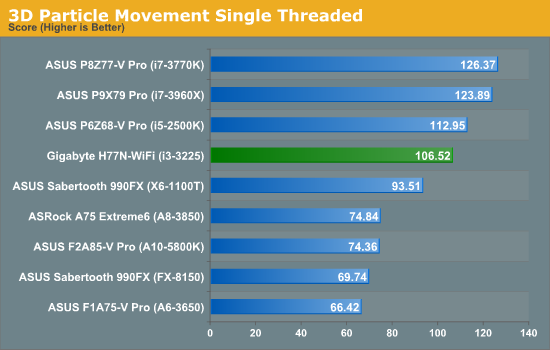
With our main comparison point being the dual module Trinity A10-5800K processor used in the F2A85-V Pro, we can safely say that single threaded performance on the Intel side is second to none – even when comparing a 3.3 GHz Intel part to a 4.2 GHz AMD part in a full FP workload.
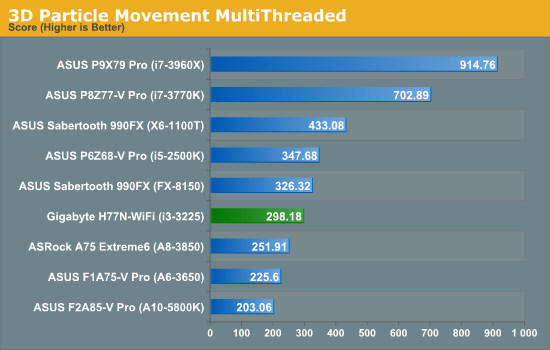
When it comes to multithreading, due to the FP nature of the benchmark, the A10-5800K is essentially dual core due to its FP unit allocation. Thus comparing the i3-3225 with Hyperthreading to the A10-5800K gives a 50% bonus to the Intel processor.
WinRAR x64 3.93 - link
With 64-bit WinRAR, we compress the set of files used in the USB speed tests. WinRAR x64 3.93 attempts to use multithreading when possible, and provides as a good test for when a system has variable threaded load. If a system has multiple speeds to invoke at different loading, the switching between those speeds will determine how well the system will do.
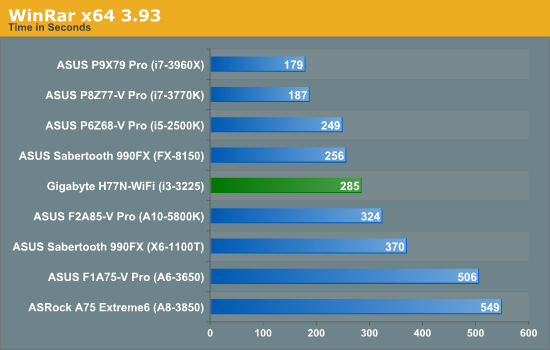
It should be noted that WinRAR does like faster memory – thus the comparison points here show an A10-5800K @ DDR3-2400 10-12-12 against an i3-3225 @ DDR3-1600 9-9-9. Despite the Intel chip having a CPU and memory disadvantage, it still manages to perform our compression test 39 seconds quicker than the AMD chip.
FastStone Image Viewer 4.2 - link
FastStone Image Viewer is a free piece of software I have been using for quite a few years now. It allows quick viewing of flat images, as well as resizing, changing color depth, adding simple text or simple filters. It also has a bulk image conversion tool, which we use here. The software currently operates only in single-thread mode, which should change in later versions of the software. For this test, we convert a series of 170 files, of various resolutions, dimensions and types (of a total size of 163MB), all to the .gif format of 640x480 dimensions.
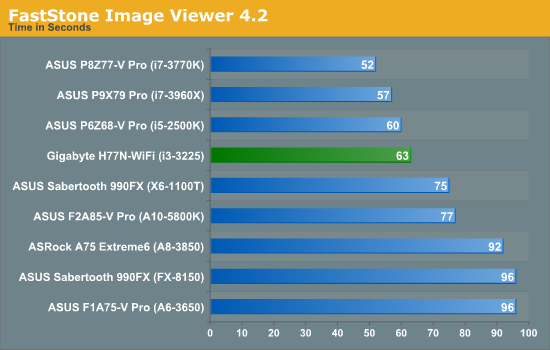
Xilisoft Video Converter
With XVC, users can convert any type of normal video to any compatible format for smartphones, tablets and other devices. By default, it uses all available threads on the system, and in the presence of appropriate graphics cards, can use CUDA for NVIDIA GPUs as well as AMD APP for AMD GPUs. For this test, we use a set of 32 HD videos, each lasting 30 seconds, and convert them from 1080p to an iPod H.264 video format using just the CPU. The time taken to convert these videos gives us our result.
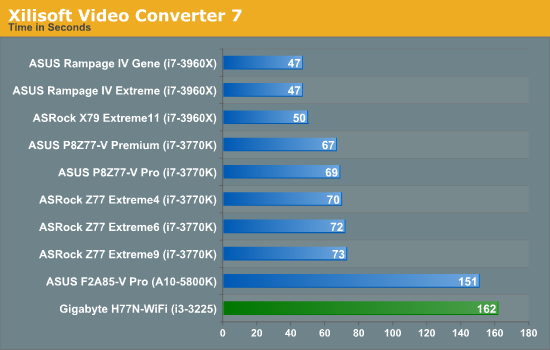
x264 HD Benchmark
The x264 HD Benchmark uses a common HD encoding tool to process an HD MPEG2 source at 1280x720 at 3963 Kbps. This test represents a standardized result which can be compared across other reviews, and is dependant on both CPU power and memory speed. The benchmark performs a 2-pass encode, and the results shown are the average of each pass performed four times.
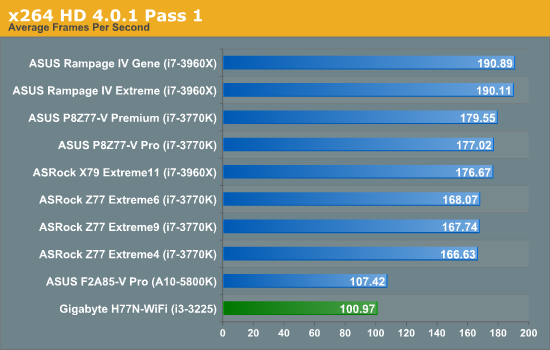
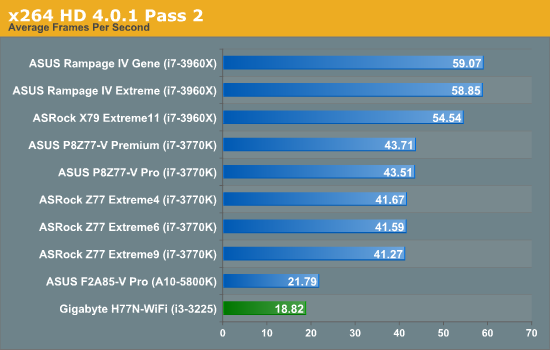










52 Comments
View All Comments
extide - Tuesday, November 6, 2012 - link
Seems like it would be more appropriate than using a 7970 or 580desiredusername145 - Wednesday, November 7, 2012 - link
C'mon Anandtech whats the point testing this with an i3???Now I wasted time even opening this article, shame on you
cjs150 - Wednesday, November 7, 2012 - link
"C'mon Anandtech whats the point testing this with an i3???"That is a bit harsh. I suspect lots of people will pair an i3 with a mini-itx board.
Personally I have an i7-3770T in my mini z77 board but lots of people would regard that as overkill (also runs a bit hot - I suspect the culprit is intel using cheap thermal paste on the IHS as widely reported).
HappyCracker - Wednesday, November 7, 2012 - link
Agreed. Even a Clarkdale i3 will happily push 1080p content to a 1080p display with its integrated graphics and I think this is where a lot of users will position their ITX boxes. As long as you're not in a huge hurry, you can also encode video. It's all about positioning the right computer in the right spot.hasseb64 - Wednesday, November 7, 2012 - link
mITX boards are more and more intresting, but I want you as a reviewer to focus more on power consumption.Th-z - Wednesday, November 7, 2012 - link
Is there going to be a review on APU (FM2) with mITX? I'm also looking for a prebuilder that sells APU mITX system using small chassis with external power supply. Puget has them using Antec ISK 110 and 310 cases, but you can only customize them for Intel parts.Last question, isn't it illogical to say "UEFI BIOS"? As UEFI is to replace BIOS, not an extension of BIOS, as "UEFI BIOS" would imply. The F in UEFI already stands for Firmware, so conceptually, it's like saying "Firmware BIOS". If wheel is to replace feet, we just need to call it wheel, not wheel feet.
Urbanos - Wednesday, November 7, 2012 - link
you didn't cover wireless! its a main feature of this mobo.missing all networking bench's, also does it allow for teaming? and how well?
did you test the raid setup? will each controller see each other's array in the config utility?
chassis options? temperatures?
dual HDMI tests and examples? image quality?
don't mean to be a dick here, but anandtech has a much higher standard than this.
klmccaughey - Wednesday, November 7, 2012 - link
We need you to spot the flaws before we buy it Ian, so I see no problem with you being critical as you are always constructive.Keep up the great reviews! I'm still waiting for my ITX HTPC killer board - they are all far to expensive.
rwpritchett - Wednesday, November 7, 2012 - link
Good review Ian. I've been running with this motherboard for about a month now in an ISK 310-150. It's good to see someone review the H77 version rather than the Z77.I'd like to add another gripe about the layout- the 24-pin power header. It's right on the top edge of the board. My case has fans on that side and the fan blades hit the clip on the power connector. If it was moved away from the edge just 2mm it would be in the clear (or better yet, it should be on the memory side of the motherboard like the Asus H77 ITX) . I had to forego a fan in that position for now, but I plan to add washers to slightly space a fan away from the 24-pin connector.
Another slight annoyance is that the BIOS refuses to see my SSD if the SATA is set to RAID. I don't know if it is specific to my model of SSD, a Crucial M4, or there is a bug that needs to be fixed.
cjs150 - Thursday, November 8, 2012 - link
Would the 24 pin position work for you ?I prefer the 24 pin to be at the edge of the board but at right angles to current position (ie not pointing straight up). Would be nice if someone would prefer a 90 degree 24 pin adapter